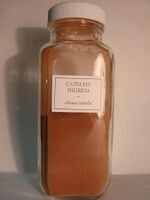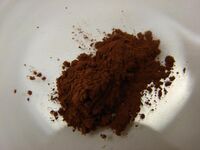Chemistry:Catechu
Catechu (/ˈkætɪʃuː/ or /ˈkætɪtʃuː/)[1] is an extract of acacia trees used variously as a food additive, astringent, tannin, and dye. It is extracted from several species of Acacia, but especially Senegalia catechu (Acacia catechu), by boiling the wood in water and evaporating the resulting brew.[2] It is also known as cutch, black cutch, cachou, cashoo, terra Japonica, or Japan earth, and also Script error: The function "transl" does not exist. in Hindi, Script error: The function "transl" does not exist. in Marathi, Script error: The function "transl" does not exist. in Odia, Script error: The function "transl" does not exist. in Assamese and Bengali, and Script error: The function "transl" does not exist. in Malay (hence the Latinized[3] Acacia catechu chosen as the Linnaean taxonomy name of the type-species Acacia plant which provides the extract).
Uses
As an astringent it has been used since ancient times in Ayurvedic medicine as well as in breath-freshening spice mixtures—for example in France and Italy it is used in some licorice pastilles. It is also an important ingredient in South Asian cooking paan mixtures, such as ready-made paan masala and gutka.
The catechu mixture is high in natural vegetable tannins (which accounts for its astringent effect), and may be used for the tanning of animal hides. Early research by Humphry Davy in the early 19th century first demonstrated the use of catechu in tanning over more expensive and traditional oak extracts.
Under the name cutch, it is a brown dye used for tanning and dyeing and for preserving fishing nets and sails. Cutch will dye wool, silk, and cotton a yellowish-brown. Cutch gives gray-browns with an iron mordant and olive-browns with a copper mordant.[4]
Black catechu has recently also been used by Blavod Drinks Ltd. to dye their vodka black.[5]
White cutch, also known as gambier, gambeer, or gambir, which is extracted from Uncaria gambir[6] has the same uses. Palm-catechu is extracted from the seeds of Areca catechu.[7]
Derivative chemicals
The catechu extract gave its name to the catechin and catechol chemical families first derived from it.
See also
- Arid Forest Research Institute
References
- ↑ catechu (3rd ed.), Oxford University Press, September 2005, http://oed.com/search?searchType=dictionary&q=catechu (Subscription or UK public library membership required.)
- ↑ Cutch and catechu plant origin from the Food and Agriculture Department of the United Nations. Document repository accessed November 5, 2011
- ↑ Derivation of word from Malay
- ↑ Goodwin, Jill (1982). A Dyer's Manual. London: Pelham Books Ltd.. p. 60. ISBN 978-0-7207-1327-5.
- ↑ Valli Herman (29 October 2003). "They drink this stuff?". LA Times. http://articles.latimes.com/2003/oct/29/food/fo-black29. Retrieved 11 March 2019. See this reference for the use of the dye in vodka
- ↑ Tanning, Dye & Processing Materials
- ↑ Buchheister G.A.: Handbuch der Drogisten-Praxis. Zweite Auflage, Springer, 1891, p. 322, Template:IA.
External links
| Wikisource has the text of the 1911 Encyclopædia Britannica article Catechu. |
 |




